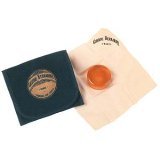
Violin rosin is resin that comes from pines and other conifer trees. It varies in color from yellow to black. At room temperature it is brittle and melts at fairly low temperatures. Because of its friction-increasing capacity, it is extensively used on
violin bows to enhance sound production. Sometimes extra substances, such as gold and silver, are added to the rosin for additional friction (and partly for sheer extravagance).
> Choose the right rosin for your instrument Violin Rosin store (links to Amazon.com)
How Violin Rosin is Made
Rosin is the resinous constituent of the oleo-resin exuded by various species of pine, known in commerce as crude turpentine. The separation of the oleo-resin into the essential oil-spirit of turpentine and common rosin is effected by distillation in large copper stills. The essential oil is carried off at a temperature of between 100° and 160° C, leaving fluid rosin, which is run off through a tap at the bottom of the still, and purified by passing through straining wadding. Rosin varies in color, according to the age of the tree whence the turpentine is drawn and the amount of heat applied in distillation, from an opaque almost pitchy black substance through grades of brown and yellow to an almost perfectly transparent colorless glassy mass. The commercial grades are numerous, ranging by letters from A, the darkest, to N, extra pale, superior to which are W, window glass, and WW, water white varieties, the latter having about three times the value of the common qualities.
Rosin is a brittle and friable resin, with a faint piny odor; the melting-point varies with different specimens, some being semi-fluid at the temperature of boiling water, while others melt at 100° to 120° C. It is very flammable, burning with a smoky flame, so care should be taken when melting it. When melted to a thick fluid, it can be surprisingly ductile. It is soluble in alcohol, ether, benzene and chloroform. Rosin consists mainly of abietic acid, and combines with caustic alkalis to form salts (rosinates or pinates) that are known as rosin soaps. In addition to its extensive use in soap-making, rosin is largely employed in making inferior varnishes, sealing-wax and various adhesives. It is also used for preparing shoemakers' wax, as a flux for soldering metals, for pitching lager beer casks, for rosining the bows of musical instruments and numerous minor purposes.
In pharmaceuticals it forms an ingredient in several plasters and ointments. On a large scale it is treated by destructive distillation for the production of rosin spirit, pinoline and rosin oil. The last enters into the composition of some of the solid lubricating greases, and is also used as an adulterant of other oils.
The chief region of rosin production is the South Atlantic and Eastern Gulf states of the United States. American rosin is obtained from Longleaf and Loblolly Pine trees. The main source of supply in Europe is the French district of Les Landes in the departments of Gironde and Landes from the Maritime Pine. In the north of Europe rosin is obtained from the Scots Pine P. sylvestris, and throughout European countries local supplies are obtained from other species of pine, with Aleppo Pine P. halepensis being particularly important in the Mediterranean region.
In addition to using rosin for stringed instruments, rosen is also used by in ballet slippers, printing inks, varnishes, glues, medicines, chewing gum, soap, paper sizing, and powder used to polish glass and lenses.

